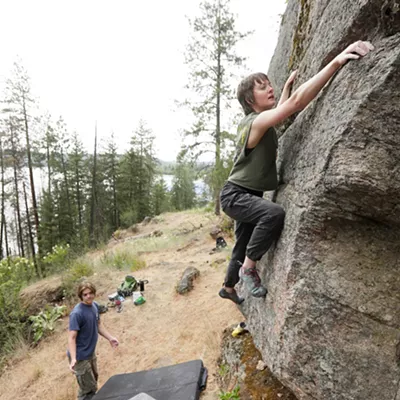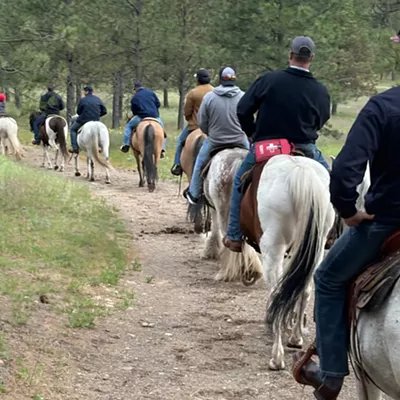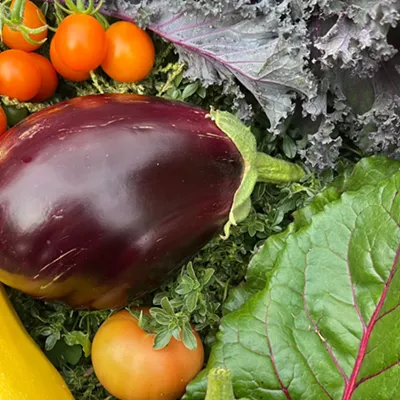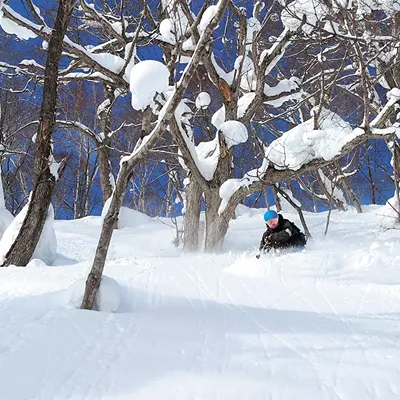A dark gray cloud hung over Mount Spokane as we marched uphill in the snow on the Kit Carson Trail. Our pants swishing, our breath huffing, the sound of snow crunching under our snowshoes and then — absolute silence.
I love hiking trails, but I'd never done so in the snow. It was my girlfriend's third snowshoe trip, but it was my first. Regardless, we were total pros — and I don't mean that ironically.
Snowshoeing is one of the most accessible winter activities one can enjoy during the winter — besides wearing sweatpants and binge-watching your favorite TV show — says Katie Wiseman, the outdoors program and outreach coordinator at REI in Spokane. Unlike snowboarding and skiing, most people already have the gear required for a day of snowshoeing, she says.
"It's becoming apparent how easy it is to get involved in snowshoeing," she says. "It's definitely growing in popularity."
The hardest part, at least for me, was strapping the shoes onto my feet. (I ate a hearty breakfast just before embarking on our trip and I may have barfed in my mouth a little after leaning forward to strap them on.)
Wiseman's been on five snowshoe hikes this year already, so I asked her for some tips to make my next snow hike even more successful.
Wiseman's advice is simple, but easy to forget: Bring the right gear, dress appropriately and plan.
Let's start from the top:
CLOTHES
Shoes: Warm. Dry. Tall. Don't wear anything fancy and don't bring ankle boots. You're going to strap snowshoes onto your boots and they are going to get wet. Wear hiking boots that you can actually hike in, Wiseman says. Also, she adds, go with wool socks if you can.
Bottoms: Wear a base layer under your pants, such as leggings or thermals. Over that, find some good snow pants, Wiseman says. "I like to wear a softshell pant. Something breathable that stretches a lot." Jeans aren't going to cut it.
Tops: Wear a base layer on top as well. Throw a midweight fleece or a "breathable warm jacket" on top, Wiseman says. Add a down vest on top of that to keep your core warm, but still allowing for flexibility, she says. Additionally, she says to bring a rain shell or large winter jacket just in case.
Ultimately, what you wear depends on your comfort level and the weather, but you also want to be prepared.
"The most important thing is to pay attention to how much you're sweating," Wiseman says. "As soon as you get hot, layers need to come off, and as soon as you get cold, layers need to come on — if not before."
EQUIPMENT
"The question I get a lot is whether you want trekking poles," Wiseman says. "The trekking pole is not a barrier to entry, but it changes the feel of the activity."
For instance, poles can help you keep balance in the snowpack, which is often uneven. They also help move some of the stress from your lower body to your upper body, she says.
Other good items she recommends snowshoers bring with them: a headlamp (if it gets dark), a thermal blanket to sit on (or sleep with if you get stranded), sunglasses (for snow glare) and water.
PLANNING
The first thing Wiseman tells me is to prepare for parking. I bought a seasonal Sno-Park pass during my visit, which is worth it if you plan to go more than once. You'll likely need a Sno-Park pass in addition to your Discover Pass for Washington State Parks. Idaho has similar parking permits for its snow parks as well, Wiseman says.
The days are shorter in winter, so you'll also want to get a good head start. Snowshoeing a couple miles takes a lot longer than hiking a normal trail, which is another good reason to bring a headlamp. However, there's an upside to getting up early.
"If you're one of the first people there on fresh snow, it's amazing," Wiseman says.
The experience can be "magical" when you're hiking on top of the snow, as tall as the trees, she says.
"The moment that you're in the trees in this snowy wonderland, it's just really special," she says. "In the winter, I think snowshoeing is one of the most enjoyable activities. It makes the short afternoons really enjoyable." ♦
Snowshoe Basics • Tue, Jan. 15 from 6-7:30 pm • Free • REI Spokane • 1125 N. Monroe • Find more workshops at rei.com/learn • 328-9900
WHERE TO RENT
• REI Spokane 1125 N. Monroe
• Spokane Library Any branch
• Mountain Gear 2002 N. Division
• Fitness Fanatics Selkirk Lodge, Mount Spokane
• Gonzaga Outdoors 702 E. Desmet Ave. (students only)
• Whitworth Rec Center 300 W. Hawthorne Rd. (students only)


















